How To Identify Human Bones From Animal Bones
From the perspective of a forensic archaeologist, what practice we do when we find homo bones? What are the of import questions to ask?
There are a range of scenarios in which members of the public see skeletal remains. Oftentimes when dog walking. The basic may be isolated or jumbled (disarticulated), or correspond a partial or complete articulated (joints maintained) skeleton. It tin be difficult to know (unless you take had preparation) whether the bones are human or brute. If in that location is uncertainty then information technology'southward of import to call the police force and non to disturb or bear on the bones.
When the police make it on the scene, their first task will be to ostend whether the bones are human or animal. If the latter, then the bones are no longer of any concern to them unless they potentially cause a risk to health. If the bones are obviously animal (e.g. antlers) the police will be able to answer the question through their own training. If they are unsure, or would like an expert opinion, they will send digital pictures of the bones to a forensic anthropologist for a speedy identification. Below is i such pic sent to forensic anthropologist Tim Thompson – it is animal bone.
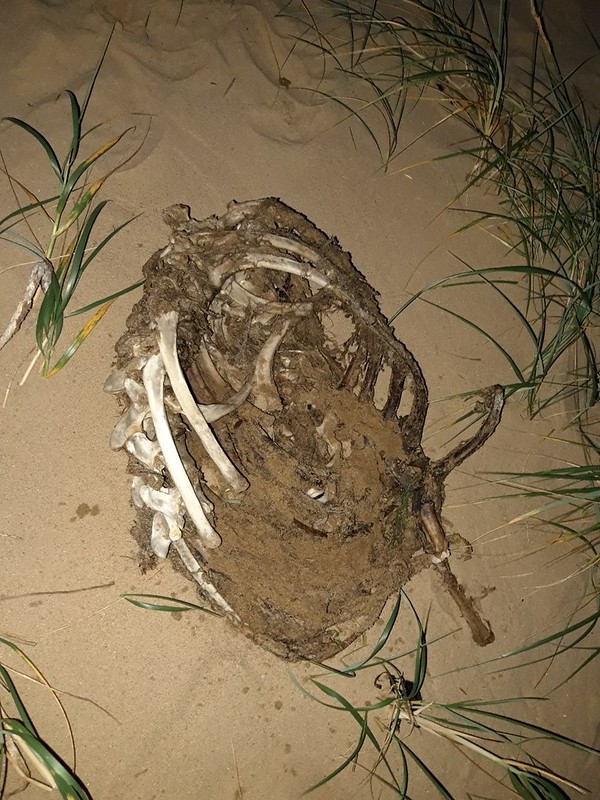 Creature basic reported to the police who and so asked a forensic anthropologist to verification that they were not-human being
Creature basic reported to the police who and so asked a forensic anthropologist to verification that they were not-human being
If the anthropologist cannot determine via photograph whether the bones are animal or human, or if they are confirmed as human, then they will attend the scene in person to propose on the correct processing of the site.
Encountering Human Bones: Questions to Inquire and the Order to Enquire them in.
The post-obit list of questions has been adjusted from John Hunter'south and Margaret Cox's (2005) volume on Forensic Archaeology.
Are the remains animal or human?
In many instances the differences between animal and human basic are quite obvious, only this isn't e'er the case. For example, human infant basic are often mistaken for brute basic and vice versa. For an expert, differences in shape and size differences should make identification articulate. Some species tin can crusade problems. For instance, in the photo beneath, the similarities betwixt the phalanges (finger bones) in a human finger and seal phalanges (bones in a seal flipper) are clear.
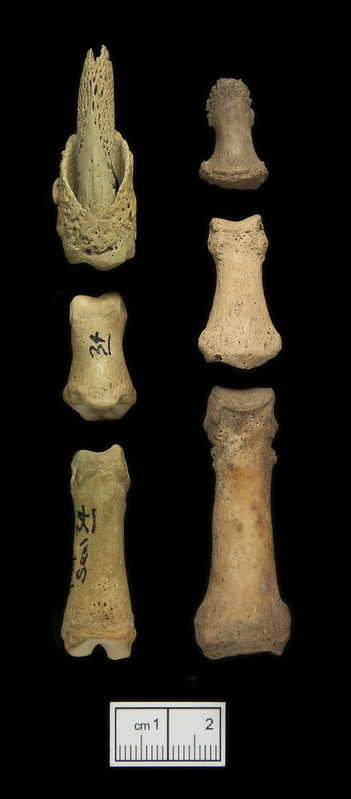
In the United states of america the similarity between some of the bones in a bear hand and human finger bones can also cause confusion. Sometimes people have mistaken human teeth (the molars) with loose teeth (pre-molars and molars) from a pig (encounter the photo below for a picture of a pig jaw). The similarities arising from the fact that both animals are omnivores.
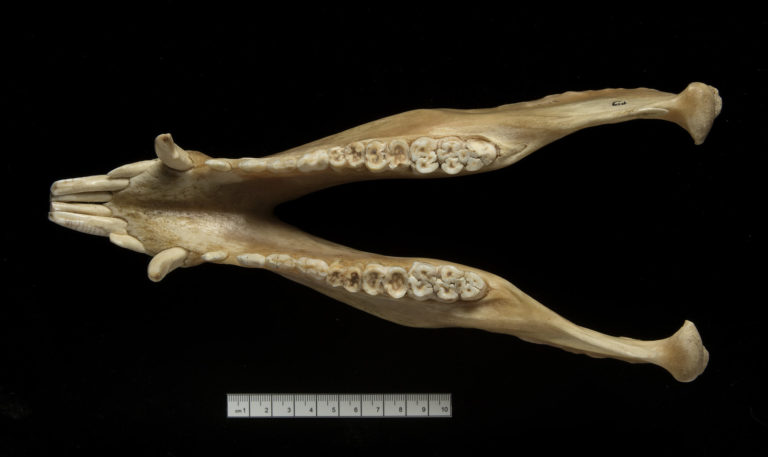
Fragmented bones may be more difficult to identify as either human or creature (see photo of bone fragments below). In these instances, histological analysis (examine a slice of bone under the microscope to see the cells) should help to respond the question. On a more low-tech notation, animal bone often has a dissimilar 'feel' to it than human bone. The composition of some animal basic, in terms of weight and texture, differs from human being bones. For case, sometimes it has a denser cortex (outer layer). DNA prove will also be useful should all else neglect, merely this is expensive and time-consuming.
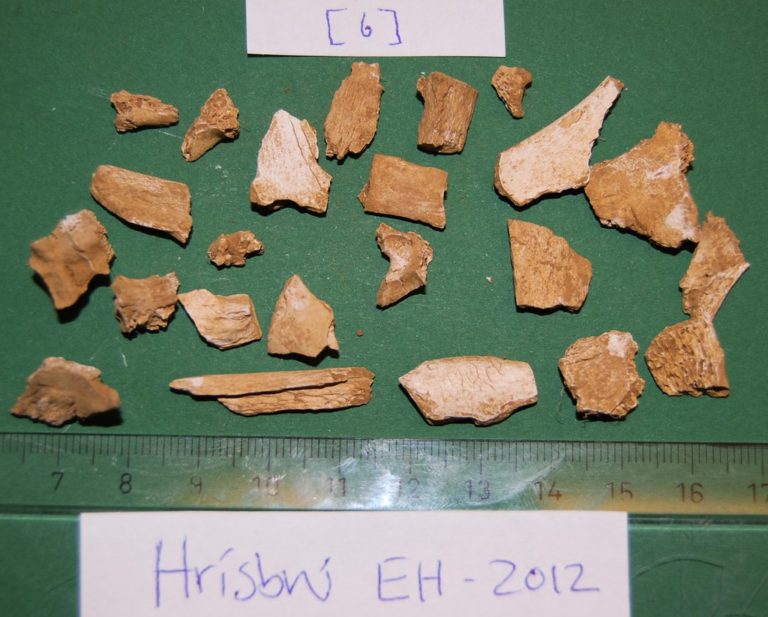 Fragmented basic are sometimes hard to differentiate from homo bone
Fragmented basic are sometimes hard to differentiate from homo bone
If human, is it ancient or modern?
Features of the burial context such every bit stratigraphic relationships, objects in the grave, or location of the grave (due east.g. association with known archaeological cemeteries) can help to establish whether it is of archaeological or forensic significance (come across the motion-picture show of the Anglo-Saxon burying beneath). In the absenteeism of contextual evidence (due east.g. a bone washed up on a beach) then directly dating of the basic using techniques such as radiocarbon dating (widely used in archæology) will constitute whether the bone is of forensic interest (loosely defined as the final 70 years).
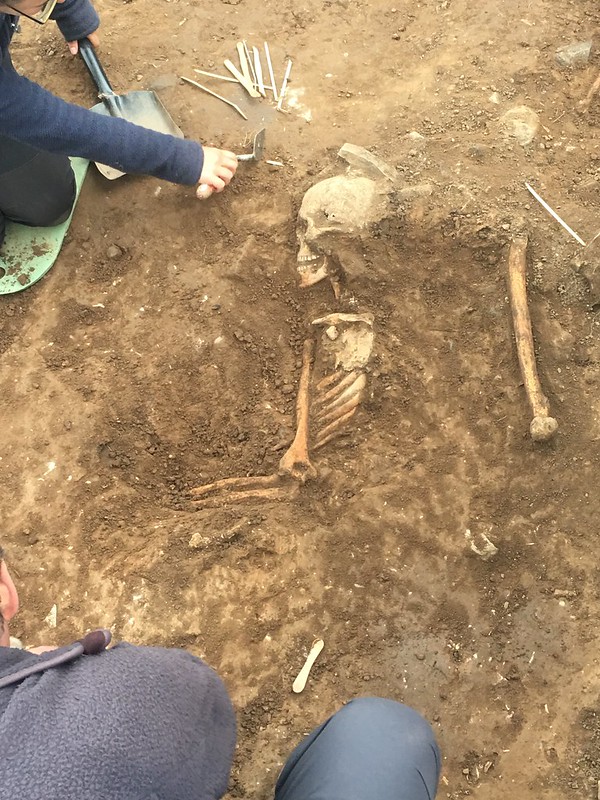 An early medieval skeleton from Lindisfarne being excavated. (Copyright David Petts)
An early medieval skeleton from Lindisfarne being excavated. (Copyright David Petts)
Radiocarbon dating has been used to date archaeological objects for many years. Information technology works on the principle that living things (plants, animals and people) absorb carbon 14 (a radioactive isotope of carbon) from the atmosphere during their lifetime. After death this carbon 14 will undergo radioactive decay according to a known timetable (one-half-life) and this is used to deduce the time since death (come across the schematic below).
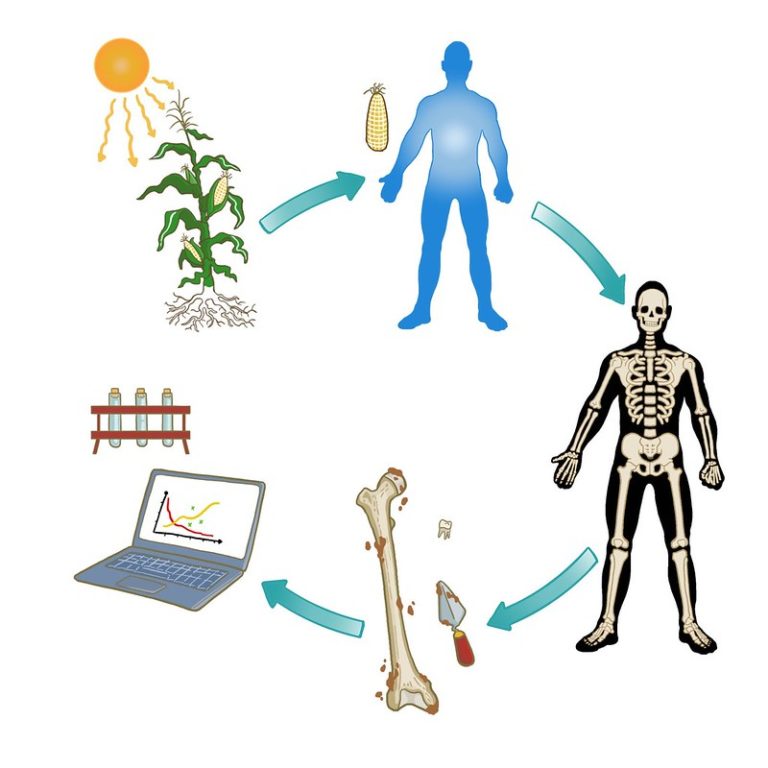
In forensic cases, radiocarbon dating tin be used to test whether a homo bone is ancient or mod because during the 1950's and 60's there was a huge fasten in radiocarbon in the atmosphere due to nuclear testing. Levels have since been decreasing. These farthermost changes in values hateful that radiocarbon can provide a useful tool for dating forensic material with reasonable accuracy (even 1-two years). Prior modern times, radiocarbon dating is much less precise and this fluctuates considerably.
Were the remains deliberately curtained or buried?
This is non e'er as clear-cut as y'all might think. Archaeological expertise is of import for interpreting natural and cultural events relating to site formation processes. For case, was the body buried within a deliberate grave cut, implying disposal by a tertiary party, or was it only laying in a natural depression, which may betoken death through exposure and natural causes? Archaeological skills are of import, therefore, for differentiating between criminal and natural activity, and interpreting the site.
If cached, how was the grave dug and with what implements?
Careful excavation by a forensic archaeologist can reveal the original edges of a grave cut. This is considering the edges of the grave will look and feel slightly different to the soil filling it and may have a subtly different colour. It's important that this work is undertaken past experienced archaeologists who can observe even very slight differences in the soil. The advent of the edges of the grave tin also be linked to different tools (e.g. mattock or shovel) used to construct the grave as these tin leave different marks in the soil.
Are there any indications that the grave was dug in a hurry (e.g. is it besides small for the body, irregular, shallow)?
If you lot've always dug a large hole you will know that it's hard work and takes quite a bit of time. If you're digging a hugger-mugger grave then y'all'll desire to get it done as soon as possible. Under these circumstances, a grave to dispose of a body is probable to exist relatively shallow and may exist irregular and too pocket-sized for the body, which then has to be bent in some mode in social club to fit it in.
Is there show that the grave was left open before the body was deposited (e.g. is there blown sediment or leaves in the bottom)?
If a murder is premeditated, the aggressor may practice some advanced planning, which includes the digging of a grave prior to the offense. If a grave is left open for a period of time, y'all would await some silt, blown-in vegetation, or other items to build up in the base and these volition end up below the body. This is the same in larger conflict scenarios. For example, during the Balkans state of war some mass graves were dug using heavy machinery and left open for some time prior to the burying of bodies.
Is there show of the corporeality of time that has elapsed since the person died (post-mortem interval)?
Equally discussed previously, there may be a number of unlike means of determining the postal service-mortem interval based on torso decomposition, stratigraphic evidence, insect action so forth. The grave itself might also contain useful information. For instance graves cut through tree roots and other flora, or containing plant droppings, can point the season in which the body was buried.
Is there prove of transfer of material from the offender to the grave or victim (e.one thousand. fibres from clothing), or 'foreign' items in the fill?
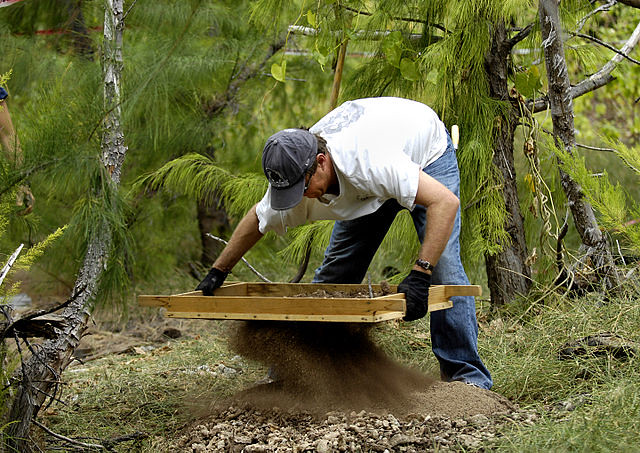 (Copyright Wikicommons)
(Copyright Wikicommons)
We all know from crime novels and TV programmes most trace evidence (tiny particles, or prints) and the passing of materials from 1 person or object onto another. Fibres from clothing, or the kicking (trunk) of a car, as well as other cloth such equally paint, glass, pilus, pollen and then along can be preserved around the body or in the make full of the grave and can provide useful testify. John Hunter (2005) discusses a example in which dark-green pigment was found on some of the stone inclusions in a grave fill. This pigment was able to exist matched through chemic analysis with a spade owned by the doubtable. It is of import to test any personal furnishings found in the grave for evidence.
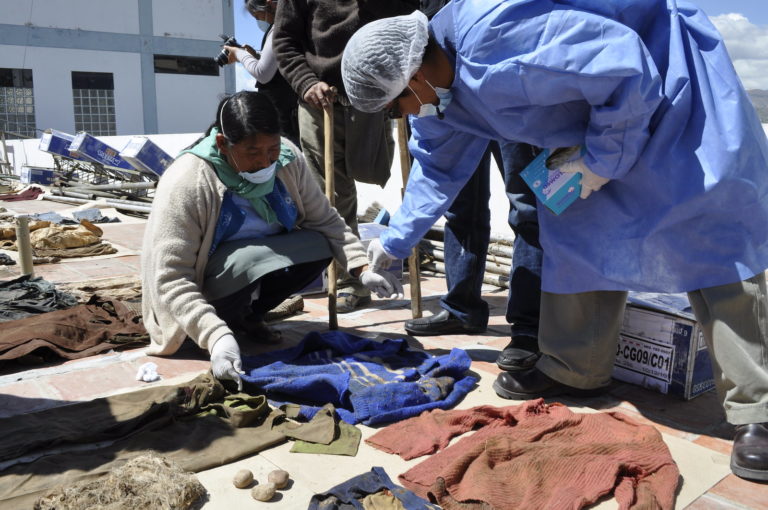 Ayacucho, Forensic Institut. With the assist of the prosecutor'southward office staff, families try to identify the clothes of their missing relatives. (Photographer, José Atauje, Copyright ICRC).
Ayacucho, Forensic Institut. With the assist of the prosecutor'southward office staff, families try to identify the clothes of their missing relatives. (Photographer, José Atauje, Copyright ICRC).
Who is the person and is there evidence of trauma on the body that is consistent with the cause of expiry?
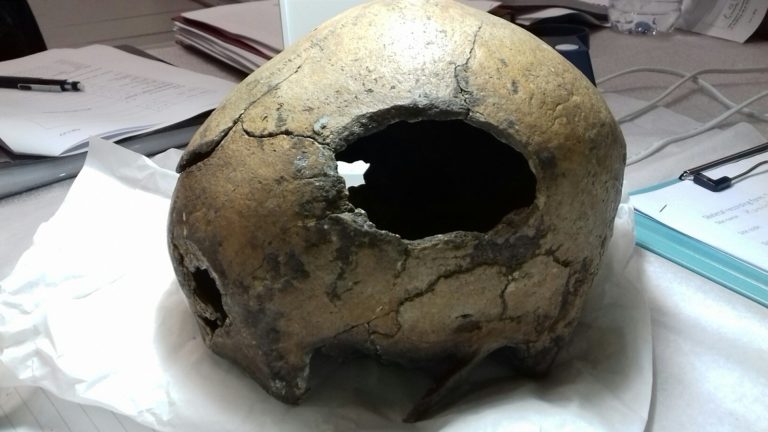 Weapon injury on an archaeological skull
Weapon injury on an archaeological skull
Once the torso is retrieved and analysed in the laboratory we desire to know who the person was and whether there is any prove of trauma consistent with the cause of death (see sharp force injury on the skulls above). In terms of establishing identity, we immediately think of Deoxyribonucleic acid testify. But this but works if yous have an idea of who the victim might be and accept a sample of DNA from a close family fellow member to match it with. Without this, there are a range of other techniques to establish identification and to examine signs of trauma. We will discuss these methods in Weeks 3 and four.
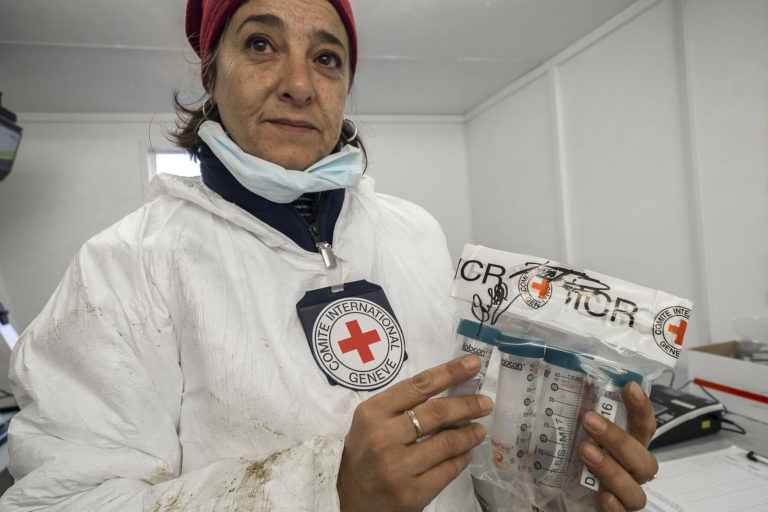 Well-nigh Darwin, Argentine military cemetery. Forensic pathologist Mercedes Salado Puerto has only sealed DNA samples into a plastic pouch which bears her signature and that of Morris Tidball-Binz, the caput of the projection. Their signatures on the sealed pouch served as a guarantee of the chain of custody until the samples arrived at the forensic genetics laboratories in Argentina, Kingdom of spain and the United Kingdom. Mercedes worked in 2013 on the exhumation of Chilean poet Pablo Neruda. (Photographer Didier Revol, Copyright ICRC)
Well-nigh Darwin, Argentine military cemetery. Forensic pathologist Mercedes Salado Puerto has only sealed DNA samples into a plastic pouch which bears her signature and that of Morris Tidball-Binz, the caput of the projection. Their signatures on the sealed pouch served as a guarantee of the chain of custody until the samples arrived at the forensic genetics laboratories in Argentina, Kingdom of spain and the United Kingdom. Mercedes worked in 2013 on the exhumation of Chilean poet Pablo Neruda. (Photographer Didier Revol, Copyright ICRC)
Source: https://www.futurelearn.com/info/courses/forensic-archaeology-and-anthropology/0/steps/67861
Posted by: mahaffeymersed.blogspot.com

0 Response to "How To Identify Human Bones From Animal Bones"
Post a Comment